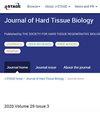Experimental Repositioning of Geranylgeranylacetone to Enhance Bone Remodeling
IF 0.4
4区 医学
Q4 ENGINEERING, BIOMEDICAL
引用次数: 0
Abstract
: Drug repositioning (DR) is a strategy to explore new medicinal effects from existing approved drugs whose safety and pharmacokinetics have already been established. We focused on geranylgeranylacetone (GGA), which is known as a heat shock proteins (HSPs) inducing agent. GGA is mainly used as a gastric mucosal protective agent; however, its effects on bone tissues have not been studied. Therefore, we hypothesized that “GGA induces HSPs in osteoblasts thereby promotes cell differentiation”, and administered GGA to MC3T3E-1 cells to examine cell responses. Methods: MC3T3E-1 were cultured in osteogenic medium. After the cultures were established, test cultures were exposed to GGA (GGA group). Cell proliferation, collage synthesis and ALP activity were measured on days 7 and 14 of culture. Alizarin Red S staining was performed on days 21 of culture. Results: On days 14 of culture, cell proliferation and collage synthesis were signifi cantly higher in the GGA group than in the control group (P<0.05). On days 7 and 14 of culture, ALP activity was signifi cantly higher in the GGA group than in the Control group (P<0.05). On days 28 of culture, the Alizarin Red S stained areas were significantly higher in the GGA group than in the control group (P<0.05). Conclusion: GGA promoted the differentia tion of MC3T3E-1 in an in vitro cell culture model. We hypothesized that GGA upregulates HSPs and promotes osteoblast differentiation and tested our hypothesis using a series of in vitro experiments. We investigated the responses and phenotypic changes occurring in MC3T3E-1 mouse osteoblast-like cells exposed to GGA. A 10 -3 M GGA concentration was applied to all cell cultures as preliminary assays demonstrated that it was the minimum concentration necessary to produce different calcification levels (unpub lished data).香叶酮重新定位促进骨重塑的实验研究
药物重新定位(Drug repositioning, DR)是一种从已经获得批准且安全性和药代动力学已经确定的药物中探索新疗效的策略。我们重点研究了香叶乙酸酮(GGA),它被称为热休克蛋白(HSPs)诱导剂。GGA主要用作胃粘膜保护剂;然而,其对骨组织的影响尚未被研究。因此,我们假设“GGA在成骨细胞中诱导热休克蛋白,从而促进细胞分化”,并将GGA注入MC3T3E-1细胞,观察细胞反应。方法:在成骨培养基中培养MC3T3E-1。培养建立后,将实验培养物暴露于GGA (GGA组)。在培养第7天和第14天测定细胞增殖、拼贴合成和碱性磷酸酶活性。第21天进行茜素红S染色。结果:培养第14天,GGA组细胞增殖和拼贴合成显著高于对照组(P<0.05)。培养第7天和第14天,GGA组ALP活性显著高于对照组(P<0.05)。培养第28天,GGA组茜素红S染色面积显著高于对照组(P<0.05)。结论:GGA促进MC3T3E-1在体外细胞培养模型中的分化。我们假设GGA上调热休克蛋白并促进成骨细胞分化,并通过一系列体外实验验证了我们的假设。我们研究了暴露于GGA的MC3T3E-1小鼠成骨细胞样细胞的反应和表型变化。10 -3 M GGA浓度应用于所有细胞培养,初步分析表明,这是产生不同钙化水平所需的最低浓度(未发表的数据)。
本文章由计算机程序翻译,如有差异,请以英文原文为准。
求助全文
约1分钟内获得全文
求助全文
来源期刊

Journal of Hard Tissue Biology
ENGINEERING, BIOMEDICAL-
CiteScore
0.90
自引率
0.00%
发文量
28
审稿时长
6-12 weeks
期刊介绍:
Information not localized
 求助内容:
求助内容: 应助结果提醒方式:
应助结果提醒方式:


